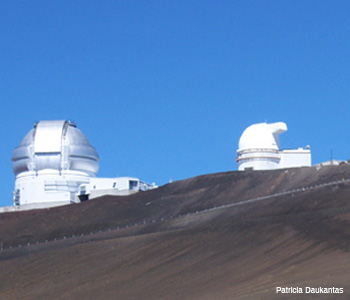
NASA's Infrared Telescope Facility (left) and the Canada-France-Hawaii telescope stand out against Mauna Kea's clear afternoon sky.
The horizontal ruts in the dirt road force vehicle drivers to shift into lower gears as their vans crawl upward toward the sky. Ahead, the road becomes low-dust asphalt, and engines and passengers strain to get enough oxygen. Finally, around the next bend, gleaming white and silver domes pop out like mushrooms against a sapphire sky.
Those domes, atop a 4,205-m Hawaiian mountain called Mauna Kea, contain some of the best optical instruments on Earth. The Mauna Kea technological arsenal includes mosaic mirrors that compensate for gravity, laser guide stars for adaptive optics and fiber-optic connections to turn free-standing telescopes into a powerful interferometer.
Mauna Kea is home to four of the 12 so-called 8-m-class optical and infrared telescopes that saw first light over the past 14 years. The growth in these large light collectors resulted from recommendations from leaders in the astronomical community, including the National Academy of Sciences’ decadal survey, and from daring innovations in mirror design and fabrication.
Worldwide, the astronomical arsenal includes two large “light buckets” optimized for spectroscopy, not imaging, and four matching telescopes destined to be linked in an interferometer. Besides Hawaii, researchers have developed sites in Texas, Arizona, Chile, the Canary Islands and South Africa for the 8-m-class ground-based telescopes.
The push to field ever-larger mirrors, however, does not mean that astronomers have abandoned smaller telescopes. Rather, researchers are still putting the 30-plus telescopes with apertures between 2.5 and 6.5 m to innovative uses, from all-sky surveys to robotic searches for near-Earth asteroids and planets around distant stars.
With the Hubble Space Telescope well into its second decade of service and the James Webb Space Telescope (JWST) scheduled for launch six years from now, why should astronomers still care about ground-based astronomy? After all, the atmosphere is opaque to important chunks of the infrared and ultraviolet spectra.
“You just can’t afford to use space except for those things that it has to do,” said J. Roger P. Angel, director of the Steward Observatory Mirror Lab at the University of Arizona.
The infrared-optimized, 6.5-m JWST, scheduled for launch no earlier than 2013, will cost at least $3.5 billion, according to current estimates. Ground-based observatories cost millions of dollars rather than billions, and they can perform useful science for decades. (Outfitted with adaptive optics, the 200-in. Hale telescope on California’s Palomar Mountain is still making discoveries nearly 60 years after its dedication.)
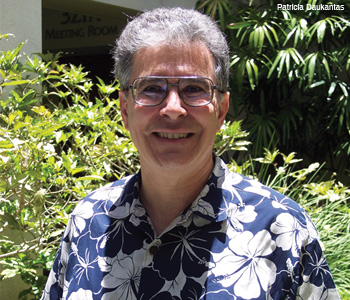
"The ground offers astronomers the opportunity to field much larger collecting areas than space telescopes, whose primary mirrors are limited by the size of launch vehicles.”
— Richard Green, director of the Large Binocular Telescope Observatory in Arizona
Also, the ground still offers astronomers the opportunity to field much larger collecting areas than space telescopes, whose primary mirrors are limited by the size of launch vehicles, said Richard Green, director of the Large Binocular Telescope (LBT) Observatory in Arizona. And, with modern high-speed electronics and controls, astronomers can compensate for the turbulence in the Earth’s atmosphere in a way that recovers a fair fraction of the diffraction-limited performance of outer-space optics.
Hawaii’s biggest eyes: the Kecks
Mauna Kea, the highest point in Hawaii, has many advantages for astronomy: dry and thin air, generally clear weather and a view of the sky from the North Star’s neighborhood to the Southern Cross. From the first 24-in. telescope built by the Air Force 40 years ago (and still in use by the University of Hawaii), research organizations have flocked to the presumed-extinct volcano to build their instruments.
The mountain has “amazingly dark skies,” said Taft Armandroff, director of the W.M. Keck Observatory. Chances are good that the night skies will stay dark for the foreseeable future, because of outdoor lighting restrictions on the Big Island of Hawaii and the state’s geographical isolation from other landmasses.
Topping the astronomical arsenal are the twin 10-m telescopes of the W.M. Keck Observatory, the largest fully steerable infrared telescopes on Earth. Each scope’s primary mirror is composed of 36 hexagonal segments, each 1.8 m in diameter. These 400-kg pieces of low-expansion glass are kept in alignment by 168 electronic sensors and 108 mechanical actuators attached behind each segment. The observatory maintains six spare mirror segments for each telescope, so that they can be swapped out periodically for realuminizing without interrupting science operations.
Astronomers can use the Keck scopes separately or together (as an interferometer), in visible or infrared wavelengths, for imaging or spectroscopy of objects that appear especially faint from Earth’s vantage point in the universe. A Berkeley-based team has used Keck, among other observatories, to find multiple planets around stars other than the Sun.
Another group from California, using Keck II and a near-infrared camera called NIRC2, located the two supermassive black holes in a pair of disk galaxies in mid-merger.
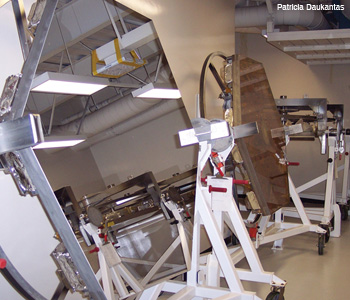 Only 36 of the 42 mirror segments are on each Keck telescope at any given time. The remaining six await maintenance in the mountaintop workshop.
Only 36 of the 42 mirror segments are on each Keck telescope at any given time. The remaining six await maintenance in the mountaintop workshop.
Geoff Marcy, astronomy professor at the University of California and a leader of the Berkeley planet team, has been using HIRES, a $10 million echelle high-resolution spectrograph, on the Keck I telescope to search for distant planetary systems. On each night of a typical observing run, he and his team observe about 120 nearby stars.
“With six nights, if the planets orbit the star in a week or less, we’d see an entire orbit on this run,” Marcy said. “That would be exciting.”
Marcy and colleagues are looking for tiny Doppler shifts in the spectra of stars as their planets are tugging at them gravitationally. The shift amounts to 1 in 108 of the wavelength of the light they’re collecting, so they must measure the spectra to eight significant digits.
Such measurements require a precise and stable setup. Marcy and R. Paul Butler, now at the Carnegie Institution of Washington, devised a way to superimpose the absorption features of iodine gas on their stellar spectra as a well-defined fiducial scale. This technique has enabled ultra-precise measurements of the “wobble” of stars around their center of mass due to the gravitational tug of a planet.
Worldwide, the Kecks were the first telescopes in the 8- to 10-m class, so they don’t look “as new and shiny as some of the other telescopes,” Armandroff said. Plans for the giant segmented mirrors took shape in the 1980s, and Keck I and II saw first light in 1993 and 1996, respectively.
Despite their enormous light-gathering capability, for many years, the Kecks’ resolution was not that radically different from every other telescope. The observatory installed its first natural-guide-star adaptive-optics system in 1999 and followed it up with a laser-guide-star (LGS) system two years ago.
All ground-based telescopes had roughly the same resolution until the advent of adaptive optics. With the LGS system, Keck can compensate for the Earth’s atmospheric turbulence over 50 times more sky area than the natural-guide-star system (OPN, March 2006, p. 10). At some infrared wavelengths, it offers better resolution than the Hubble Space Telescope—and with 16 times the light-gathering power of Hubble.
“We’re tremendously excited to be getting images that, for most of my career, I never would have thought possible, and the scientific knowledge that it [adaptive optics] has been enabling,” Armandroff said.
The Geminis
The Gemini North telescope has an 8.1-m primary mirror and is one of a pair of 8.1-m telescopes pointing at different regions of the sky. Its twin, Gemini South, is on Cerro Tololo, a mountain about 500 km north of Santiago, Chile. A multinational consortium operates both observatories.
The Gemini telescopes have some matching instruments and others that are specific to each observatory. For instance, both scopes are outfitted with multi-object spectrographs that can perform both imaging and spectroscopy over a 5.5-arcmin-square region. Each scope has near-infrared (1-5 µm) and mid-infrared (roughly 7-25 µm) imaging and spectrographic capabilities as well.
Other Gemini instruments have a single purpose. For example, the Near-Infrared Coronagraphic Imager (NICI) will attempt to take images of Jupiter-class planets around other stars when it goes into service on Gemini South late this year.
According to Michael C. Liu, a University of Hawaii astronomer who leads the NICI team, radial-velocity and transit searches tend to find planets that are relatively close to their central star: less than 4 astronomical units (AU) and sometimes a fraction of an AU. (One AU is equal to the distance between the Earth and the sun—about 150 million km.) Direct imaging is best for exploring the outer regions of planetary systems, where cool gas-giant planets are expected to form.
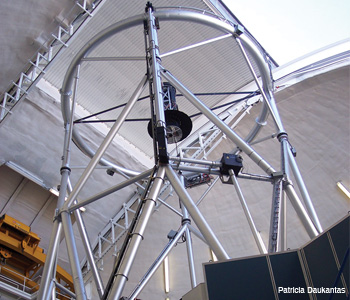 The Gemini North telescope points to zenith when not in use. The slit in the observatory dome opens and closes as part of the pre-observing tests.
The Gemini North telescope points to zenith when not in use. The slit in the observatory dome opens and closes as part of the pre-observing tests.
Built by a company in Hilo, NICI saw first light on Gemini South in February and is now undergoing commissioning tests. Once the shakedown is complete in late 2007, Liu’s planet-hunting team will start a 50-night campaign to observe up to 200 stars within 30 light-years of Earth.
With NICI’s 85-element adaptive optics system and infrared (1 to 5 µm) camera, Liu’s team will search for planets in the 1.58- and 1.65-µm methane bands. Methane is a small but important component of Jupiter, Saturn, Uranus and Neptune.
Also atop Mauna Kea is Subaru, an 8.2-m optical-infrared telescope built by the National Astronomical Observatory of Japan (NAOJ). Its name comes not from the automobile manufacturer, but from the Japanese name for the Pleiades star cluster.
Like the Keck segments, Subaru’s mirror, made of ultra-low-expansion glass, is supported by 261 actuators that maintain the shape of the glass as the telescope moves. Subaru sits in a cylindrical, rather than spheroidal, enclosure that was designed to circulate air without causing excessive turbulence, which interferes with visibility.
The Multi-Object Infrared Camera and Spectrograph (MOIRCS) for Subaru went into active service in February 2006, according to Tohoku University astronomer Takashi Ichikawa. MOIRCS, a collaboration between NAOJ and Tohoku, was completely built in Hilo, Hawaii, the closest city to Mauna Kea. The slit-mask exchanger enabled the camera-spectrograph’s broad field of view (4 arcmin by 7 arcmin) and allowed the instrument to gather spectra from multiple target objects.
Other 8-m-class telescopes
Keck I and Keck II are not the only telescopes with so-called mosaic mirrors. The Hobby-Eberly Telescope (HET), at the McDonald Observatory in the mountains of west Texas, has a primary mirror that consists of 91 hexagonal mirror segments. Its effective aperture is 9.2 m.
HET also has a number of innovations that made it a low-cost instrument optimized for spectroscopy, not imaging. For instance, for most imaging telescopes, the entire telescope must be pointed at the target. The mirror and frame of HET, however, remain stationary, while the instrument package, 13 m above the primary mirror, moves to track the target. This type of tracking system was most famously used in the Arecibo radio telescope in Puerto Rico.
Inspired by HET, the South African Astronomical Observatory recently built a slightly larger mosaic telescope, the Southern African Large Telescope (SALT). SALT, also with 91 hexagonal mirrors in an array, uses much of HET’s technology with some alterations to correct some minor problems in the original HET.
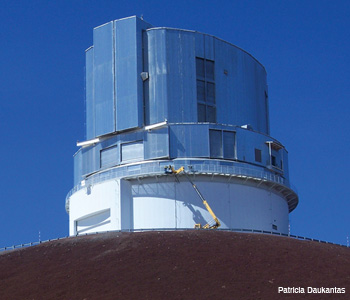 Like the Keck segments, Subaru’s mirror, made of ultra-low-expansion glass, is supported by 261 actuators that maintain the shape of the glass as the telescope moves.
Like the Keck segments, Subaru’s mirror, made of ultra-low-expansion glass, is supported by 261 actuators that maintain the shape of the glass as the telescope moves.
Four other 8.2-m telescopes scan the Southern Hemisphere skies from Europe’s Paranal Observatory in Chile. The quartet will be linked together interferometrically to make one of the newest class of extremely large telescopes, or ELTs.
A laboratory for really big mirrors
Angel, the 2007 winner of OSA’s Joseph Fraunhofer Award/Robert M. Burley Prize for optical engineering, has developed a reputation for innovation in the design and construction of large telescope mirrors. He designed a spin-cast technique in which a rotating furnace heats and melts chunks of borosilicate glass, then cools the spinning glass slowly until it solidifies with a near-parabolic shape on its top surface and a honeycomb structure underneath.
The honeycomb improves mirror performance and saves money. Honeycombed mirrors have low thermal inertia, which lessens convective distortion. (Of course, the idea is not entirely new; the Hale telescope’s 200-in. mirror, cast in 1935 without spinning, had a similar honeycomb design to reduce its weight.)
“Because these mirrors are very big and have very short focal ratios, you’d be involved in grinding out about 50 tons of glass if you didn’t spin,” Angel said. With the glass so big and the sagittal depth (the depth from the edge to the center of a concave mirror) so deep, it just became more economical to spin the hot glass into its approximate shape.
In the case of the LBT mirrors, which, of the Mirror Lab’s past projects, have the shortest focal length and are the fastest at about f/1.1, the sagittal depth is about 18 in. Since the mirror is roughly 26 feet across, “that would be a lot of glass to dig out,” Angel said.
A telescope with a short, fast mirror fits in a small building, and observatory costs typically equal telescope costs. By making the telescope enclosure smaller, the telescope’s owner can save money, Angel said.
Dual eyes on the sky
With new telescopes come new locations, as developed “sky islands” such as Kitt Peak and Mauna Kea run out of room for new observatories. Mount Graham, in eastern Arizona, is a relatively high site with low water vapor for observing in the mid-infrared. It is also far enough from the encroaching light pollution of Phoenix and Tucson to host the LBT Observatory.
In a sense, the LBT is the first of the ELTs, Green said. Together, the twin mirrors stretch 23 m from end to end. As a result, it will produce images that have about the resolution of many of the planned ELTs, even though it won’t collect quite as many photons as an ELT.
Working together, the common-mounted telescopes will make a Fizeau interferometer, according to Green. When the whole system is in full operation with near-IR adaptive optics, the LBT will provide 10 times the resolution of the Hubble Space Telescope over a 10-arcsec field of view—enough to provide detailed views of a region of a nearby galaxy.
LBT is the pathfinder for the next generation of large telescopes, Green said. “It’s to get a taste of what a 24-m telescope is going to tell us.”
Unique in astronomy, one of the LBT’s matching telescopes is optimized for UV and blue and the other for red and infrared. Researchers can point them at the same field of view and record in two different colors.
In the near future, the LBT team will replace the scope’s conventional secondary mirror with an adaptive-correcting secondary mirror designed by scientists in Italy and the University of Arizona. The face sheet of the adaptive secondary mirror will be 91 cm in diameter, and it will be 1.6-mm thick. A total of 672 magnets glued on the back of the mirror will change the secondary’s curvature at a 1-kHz rate.
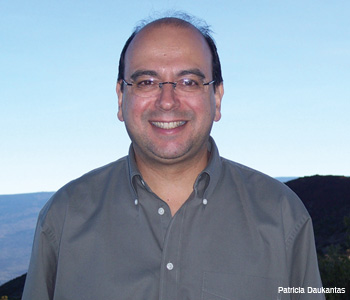 We’re tremendously excited to be getting images that, for most of my career, I never would have thought possible.”
We’re tremendously excited to be getting images that, for most of my career, I never would have thought possible.”
— Taft Armandroff, director of the W.M. Keck Observatory
Proposed extremely large telescopes
Astronomers are scrambling to fund the next generation of reflecting telescopes with apertures of 24 to 42 m. These planned instruments are stretching the limits of glass-mirror technology, not to mention the list of superlatives.
The planned Giant Magellan Telescope (GMT) will use seven 8.4-m mirrors, arranged in a ring of six, plus one in the center, to form a 22-m, f/0.7 primary aperture.
The Mirror Lab is currently working on the first of the GMT mirrors. It’s an off-axis mirror with the most aspheric surface ever manufactured, Angel said.
“The metrology to get that right to the diffraction limit is pretty demanding.”
The Mirror Lab is working at the limit of what it can build, and to make a bigger telescope, it simply has to replicate the 8.4-m mirror size. The laboratory is limited by the size of its building on the Arizona campus and the size of U.S. freeways, among other things.
Some of the plans for next-generation ELTs involve linking existing 8-m-class scopes together to perform interferometry. For example, ’OHANA is a scheme to link the seven largest telescopes on Mauna Kea with fiber optics for interferometric imaging at near-infrared wavelengths (OPN, April 2006, p. 8).
Four identical, European-built 8.2-m telescopes atop a Chilean mountain are being similarly combined to form the Very Large Telescope (VLT). This spring, researchers at the Max-Planck Institute for Extraterrestrial Physics released the first images taken with a laser guide star system on two of the four scopes.
Of course, the numerous existing telescopes with apertures below 8 m still have many years of productive science ahead of them. These include the 6-m MMT in Arizona, the two Magellan telescopes at Las Campanas in Chile and the 5-m (200-in.) Hale telescope on Mount Palomar. The U.S. astronomical community recently organized ReSTAR, or Renewing Small Telescopes for Astronomical Research, to develop scientifically useful projects for scopes with apertures of less than 6.5 m.
If Palomar Observatory’s example is any indication, the Keck, Subaru, Gemini and Hobby-Eberly telescopes and their extremely large cousins will be exploring the heavens well into the middle of this century. Undoubtedly, decades of exciting discoveries lie ahead. As Armandroff said: “The best paper from Keck is probably still to come.”
The author thanks Stephen Maran of the American Astronomical Society (AAS) and Peter Michaud and R. Scott Fisher, both of the Gemini Observatory, for organizing a press tour of the Mauna Kea summit during the AAS meeting in May 2007.
[ Patricia Daukantas is the senior writer/editor of Optics & Photonics News. ]
References and Resources
>> S.C. Barden. “Fiber Optics in Astronomical Instruments,” Opt. Photon. News 7(2), 34 (February 1996).
>> R.P. Butler et al. “Catalog of Nearby Exoplanets,” Astrophys. J. 646, 505 (2006); also at www.exoplanets.org.
>> J.D. Crane et al. “The Carnegie Planet Finder Spectrograph,” online at www.ociw.edu/~crane/pfs/docs/SPIE-poster-2006.pdf.
>> R. Gilmozzi. “Giant Telescopes of the Future,” Sci. Am. 294(5), 64 (May 2006).
>> M. Lloyd-Hart and R. Angel. “Imaging Giant Extra-Solar Planets from the Ground,” Opt. Photon. News 11(10), 42 (October 2000).
>> C.E. Max et al. “Locating the Two Black Holes in NGC 6240,” Science 316, 1877 (2007).
>> P. Wizinowich et al. “First Light Adaptive Optics Images from the Keck II Telescope: A New Era of High Angular Resolution Imagery,” Publ. Astron. Soc. Pac. 112, 315 (2000).
